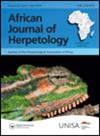Acoustic communication and reproductive behaviour in the aquatic frog Xenopus laevis (Pipidae), a field study
IF 0.9
4区 生物学
Q3 ZOOLOGY
引用次数: 11
Abstract
Abstract We studied the acoustic and reproductive behaviour of the clawed frog, Xenopus laevis, in a pond with clear water in South Africa over a period of two months. It contained 21 adult males and females. Each was marked with a transponder so that the behaviour of individuals could be tracked. The animals inhabited the bottom of the pond. They were active from dusk to midnight. Series of nights in which several males called alternated with series without calling. Simultaneous calls were not synchronised. On nights when males called, several of them established territories on the bottom of the pond that they defended against other males. They delineated the territory by calling along its borders. When meeting a male intruder they emitted an encounter call, followed by a fighting call if they fought. At the end of a fight the loser emitted a release call. Territories could remain constant over several weeks. They were abandoned on nights without calling, but re-established by the same individuals at the same locations on nights with calling. When a female entered a territory, the male approached, started the courtship call and attempted amplexus. The female usually rejected the male while emitting a release call. Females spawned synchronously on one or two nights, with weeks without oviposition in-between. Eggs were laid individually or in small groups on hard structures all over the pond. The adults preyed upon the tadpoles and only a few single tadpoles remained after two weeks. Raising the water level stimulated calling activity.水蛙爪蟾的声交流与生殖行为的野外研究
摘要在南非一个清澈的池塘中,我们对爪蟾(Xenopus laevis)的声学和生殖行为进行了为期两个月的研究。其中包括21名成年男性和女性。每个都有一个应答器,这样就可以追踪到个体的行为。动物们住在池塘的底部。他们从黄昏一直活动到午夜。一连串的夜晚,几只雄性轮流叫唤,另一些则不叫唤。同时呼叫不同步。在雄性鸣叫的夜晚,它们中的一些在池塘底部建立了领地,以防御其他雄性。他们沿着边界划定领土。当遇到雄性入侵者时,它们会发出“遇到”的叫声,如果它们打架了,就会发出“打架”的叫声。在战斗结束时,失败者发出释放呼叫。领土可能在数周内保持不变。它们在没有鸣叫的夜晚被遗弃,但在有鸣叫的夜晚,由同一个人在同一地点重新建立起来。当雌性进入领地时,雄性就会靠近,开始发出求偶的叫声,并试图交配。雌性通常在发出释放叫声的同时拒绝雄性。雌性在一个或两个晚上同步产卵,中间有几周没有产卵。卵被单独或小群地产在池塘各处的坚硬结构上。成年蝌蚪捕食,两周后只剩下几只蝌蚪。提高水位刺激了叫声活动。
本文章由计算机程序翻译,如有差异,请以英文原文为准。
求助全文
约1分钟内获得全文
求助全文
来源期刊

African Journal of Herpetology
ZOOLOGY-
CiteScore
3.00
自引率
6.70%
发文量
15
审稿时长
>12 weeks
期刊介绍:
African Journal of Herpetology (AJH) serves as an outlet for original research on the biology of African amphibians and reptiles. AJH is an interdisciplinary journal that publishes original articles and reviews from diverse fields and disciplines, such as conservation, phylogenetics, evolution, systematics, performance, physiology, ecology, behavioural ecology, ethology, and morphology.
The Journal publishes two issues a year. There are no page charges .
 求助内容:
求助内容: 应助结果提醒方式:
应助结果提醒方式:


